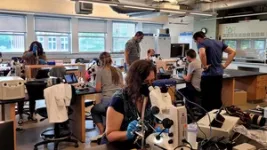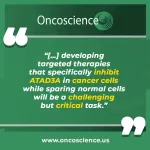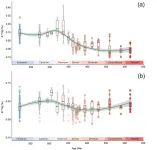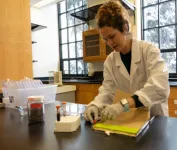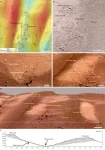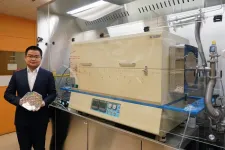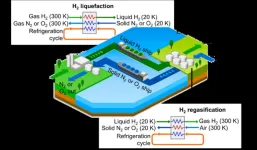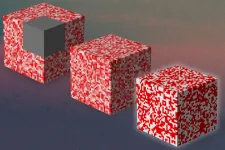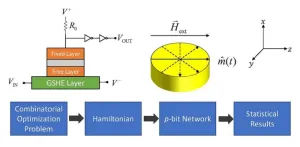(Press-News.org) WOODS HOLE, Mass. –Twelve accomplished science and health journalists have been awarded a highly competitive fellowship in the Logan Science Journalism Program at the Marine Biological Laboratory (MBL).
Now in its 36th year, the Logan Science Journalism Program provides journalists with immersive, hands-on research training, giving them invaluable insight into the practice of science as well as some of the major news stories of today. The program, which offers a Biomedical course and an Environmental course, will run May 30-June 9 in Woods Hole.
Biographies for the 2023 Logan Science Journalism Fellows are here. They are:
Biomedical Fellows
Charles Bergquist, Director and Senior Producer, “Science Friday”
Katie Hunt, Science Writer/Editor, CNN (London, UK)
Petria Ladgrove, “What the Duck?!” Podcast Producer, Science Unit, Australian Broadcasting Corp.
Blacki Migliozzi, Graphics Editor, The New York Times
Mohamed Mansour, Science Journalist, Scientific American (Cairo, Egypt)
Carlos Andres Serrano, Multimedia Broadcast Journalist, British Broadcasting Corp. (BBC)
Environmental Fellows
Morgan Krakow, Reporter, Anchorage Daily News
Barbara Moran, Correspondent, WBUR (National Public Radio, Boston)
Annalee Newitz, Freelance Science Journalist (San Francisco)
Melba Newsome, Independent Journalist (Charlotte, NC)
Julia Sklar, Independent Science Journalist (Boston)
Duy Linh Tu, Documentary Filmmaker, Journalist, and Associate Professor at Columbia Graduate School of Journalism
Learning by Doing
In the program’s Biomedical Hands-On Research Course, fellows learn fundamental techniques and approaches that underpin current biomedical science. Guided by senior scientists, they undertake pioneering technologies for imaging and analyzing the human microbiome; genome editing using CRISPR/Cas9; and DNA sequencing and analysis. They will also have ample opportunity to discuss concepts and innovations in biological and biomedical science with the program’s faculty.
In the Environmental Hands-On Research Course, fellows conduct field research at a barrier beach, salt marsh, and watershed ecosystem on Cape Cod. They discover the complex ways that added nitrogen alters coastal ecosystems, including their capacity to keep up with sea-level rise and impacts on marine life and coastal food webs.
All fellows collect, analyze, and interpret research data, which they present at a mini-symposium at the close of the fellowship. They also have opportunities to explore the rich scientific resources in Woods Hole.
The Biomedical Hands-On Research Course is co-directed by Joshua Rosenthal, Ph.D., senior scientist in the MBL’s Bell Center, and Scott Chilimeski, Ph.D., research scientist in the MBL’s Bay Paul Center. The course’s journalism advisor is Maryn McKenna, journalist, author, senior writer at WIRED, and Senior Fellow of the Center for the Study of Human Health at Emory University.
The Environmental Hands-On Research Course is directed by Anne Giblin, Ph.D., senior scientist and director of the MBL Ecosystems Center, with faculty Javier Lloret, Ph.D., research scientist in the Ecosystems Center. Science journalist/producer Angela Posada-Swafford is the course’s journalism advisor.
Over the years, the Logan Science Journalism Program has granted fellowships to hundreds of journalists from prominent news organizations, including The New York Times, The Wall Street Journal, Science, National Public Radio, The Washington Post, USA Today, CNN, and Scientific American.
—###—
The Marine Biological Laboratory (MBL) is dedicated to scientific discovery – exploring fundamental biology, understanding marine biodiversity and the environment, and informing the human condition through research and education. Founded in Woods Hole, Massachusetts in 1888, the MBL is a private, nonprofit institution and an affiliate of the University of Chicago.
END
Twelve outstanding journalists named 2023 MBL Logan Science Journalism Fellows
2023-04-28
ELSE PRESS RELEASES FROM THIS DATE:
Improved gene editing method could power the next generation of cell and gene therapies
2023-04-28
PHILADELPHIA— A new approach to the genetic engineering of cells promises significant improvements in speed, efficiency, and reduction in cellular toxicity compared to current methods. The approach could also power the development of advanced cell therapies for cancers and other diseases, according to a study from researchers in the Perelman School of Medicine at the University of Pennsylvania.
In the study, which appeared this week in Nature Biotechnology, researchers found that protein fragments used by some viruses to help them get into cells could ...
ATAD3A: A molecular determinant favoring head and neck cancer development
2023-04-28
“[...] developing targeted therapies that specifically inhibit ATAD3A in cancer cells while sparing normal cells will be a challenging but critical task.”
BUFFALO, NY- April 28, 2023 – A new research perspective was published in Oncoscience (Volume 10) on April 4, 2023, entitled, “Mitochondrial regulator ATAD3A: a molecular determinant favoring head and neck cancer development.”
In addition to their role in energy metabolism, mitochondria play important roles in other cellular processes, such as apoptosis, calcium signaling and the synthesis of certain biomolecules. Mitochondria have also been ...
Vascular plants colonized land extensively by the early Silurian: Study
2023-04-28
The colonization and expansion of plants on land represent a defining landmark for the path of life on Earth. Terrestrial colonization has been attributed to a series of major innovations in plant body plans, anatomy, and biochemistry that transformed global biogeochemical cycles and climates.
It is crucial to identify the onset and track the expansion of those earliest land plants. However, the precise timing of land colonization by vascular plants remains controversial due to the sparseness of early land plant megafossils, poor stratigraphic controls ...
Machine learning helps scientists identify the environmental preferences of microbes
2023-04-28
Researchers have figured out a way to predict bacteria’s environmental pH preferences from a quick look at their genomes, using machine learning. Led by experts at the University of Colorado Boulder, the new approach promises to help guide ecological restoration efforts, agriculture, and even the development of health-related probiotics.
“We know that in any environment, there’s a ton of bacteria with important ecological functions, but their environmental preferences often remain unknown,” said Noah Fierer, a fellow of the Cooperative Institute for Research in Environmental ...
Tianwen-1: Zhurong Rover finds evidence of water at low latitudes on modern Mars
2023-04-28
The Zhurong rover has found evidence of water on dune surfaces on modern Mars by providing key observational proof of liquid water at low Martian latitudes, according to a study led by Prof. QIN Xiaoguang from the Institute of Geology and Geophysics (IGG) of the Chinese Academy of Sciences (CAS).
The study was published in Science Advances on April 28.
Researchers from the National Astronomical Observatories of CAS and the Institute of Atmospheric Physics of CAS were also involved in the study.
Previous ...
Looking for insights from our nearest star-forming galaxy
2023-04-28
Vallia Antoniou, an assistant professor of practice in the Department of Physics and Astronomy at Texas Tech, has been awarded observing time on the powerful Chandra X-Ray Telescope to explore some of the deepest recesses of the universe.
It marks the second major Chandra program led by Antoniou, who is also a research associate with the Smithsonian Astrophysical Observatory.
Each year, astronomers from around the world follow a rigorously competitive process to receive Chandra time. The telescope was launched aboard the space shuttle Columbia in 1999 and orbits Earth, offering previously unavailable views of deep space at wavelengths that are not accessible from ground telescopes. During ...
MIT engineers “grow” atomically thin transistors on top of computer chips
2023-04-28
CAMBRIDGE, MA — Emerging AI applications, like chatbots that generate natural human language, demand denser, more powerful computer chips. But semiconductor chips are traditionally made with bulk materials, which are boxy 3D structures, so stacking multiple layers of transistors to create denser integrations is very difficult.
However, semiconductor transistors made from ultrathin 2D materials, each only about three atoms in thickness, could be stacked up to create more powerful chips. To this end, MIT researchers have now demonstrated a novel technology that can effectively ...
How solid air can spur sustainable development
2023-04-28
The green hydrogen economy is a sustainable alternative to fossil fuels. However, one of the challenges of constructing a global hydrogen economy is hydrogen transportation by sea. A new paper proposes solid air as a medium for recycling cold energy across the hydrogen liquefaction supply chain.
The world is undergoing an energy transition to reduce CO2 emissions and mitigate climate change. The COVID-19 pandemic and the Russia-Ukraine war have further increased the interest of Europe and Western countries to invest in the hydrogen economy as an alternative to fossil fuels. Hydrogen can significantly reduce geopolitical risks ...
Deep-learning system explores materials’ interiors from the outside
2023-04-28
CAMBRIDGE, MA — Maybe you can’t tell a book from its cover, but according to researchers at MIT you may now be able to do the equivalent for materials of all sorts, from an airplane part to a medical implant. Their new approach allows engineers to figure out what’s going on inside simply by observing properties of the material’s surface.
The team used a type of machine learning known as deep learning to compare a large set of simulated data about materials’ external force fields and the corresponding internal structure, and used that to generate a ...
Solving computationally complex problems with probabilistic computing
2023-04-28
According to computational complexity theory, mathematical problems have different levels of difficulty in the context of their solvability. While a classical computer can solve some problems (P) in polynomial time — i.e., the time required for solving P is a polynomial function of the input size — it often fails to solve NP problems that scale exponentially with the problem size and thus cannot be solved in polynomial time. Classical computers based on semiconductor devices are, therefore, inadequate ...

